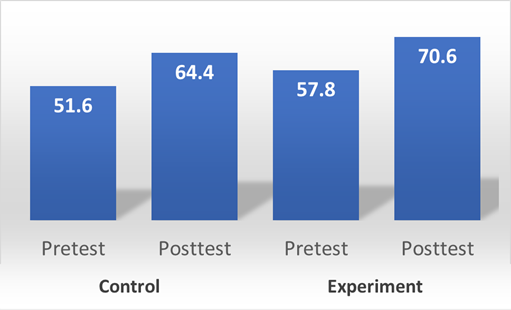The Effectiveness of PBL-Based Electronic Modules in Improving Students' Critical Thinking and Problem-Solving Skills at SMK Negeri 4 Pariaman
##plugins.themes.academic_pro.article.main##
Abstract
The problem in the learning process is that many students lack focus and motivation to learn when teachers deliver material. The cause is a learning model that is not interactive enough, where teachers often use a one-way learning approach. In addition, teachers have not mastered or utilized interactive learning media beyond the use of PowerPoint. This condition not only reduces the effectiveness of learning but also has a negative impact on students' critical thinking and problem-solving abilities. The purpose of this study is to look at how using a Problem-Based Learning method with electronic module media affects students' ability to think critically and solve problems in the subject of Electronics Basics at State Vocational High School 4 Pariaman. This research is a quantitative study that uses an experimental approach, specifically a Quasi-Experimental Design called the Non-Equivalent Control Group Design. The students involved were all from class X TEI during the 2022/2023 school year. The data analysis showed that using the Problem-Based Learning method with Augmented Reality media had a significant effect on the critical thinking and problem-solving skills of Industrial Electronics Engineering students. The control group saw an average improvement of 24.81%, while the experimental group had an average improvement of 22.13%.
##plugins.themes.academic_pro.article.details##
References
- Y. Andrian and R. Rusman, “Implementasi pembelajaran abad 21 dalam kurikulum 2013,” J. Penelit. Ilmu Pendidik., vol. 12, no. 1, pp. 14–23, 2019, doi: 10.21831/jpipfip.v12i1.20116.
- D. Yulia, M. Permata, and M. Anwar, “Analysis of Critical Thinking Skills on the Use of Augmented Reality with the TAM Approach,” J. Eng. Collab. Learn., pp. 18–24, 2024.
- N. Jalinus et al., “Developing Blended Learning Model in Vocational Education Based On 21st Century Integrated Learning and Industrial Revolution 4.0,” Turkish J. Comput. Math. Educ., vol. 12, no. 9, pp. 1276–1291, 2021.
- A. Huda et al., “Augmented Reality Technology as a Complement on Graphic Design to Face Revolution Industry 4.0 Learning and Competence: The Development and Validity,” Int. J. Interact. Mob. Technol., vol. 15, no. 5, pp. 116–126, 2021, doi: 10.3991/ijim.v15i05.20905.
- M. Anwar, T. Taali, H. Hidayat, and E. Sabrina, “Exploring Trait Thinking in Predicting Students’ Higher-Order Thinking Skills (HOTS) Using ANFIS: A Study on Electronics Engineering Education Students,” TEM J., vol. 13, no. 4, pp. 3103–3111, 2024, doi: 10.18421/TEM134-45.
- A. Huda et al., Media Animasi Digital Berbasis Hots (Higher Order Thinking Skill). Padang: UNP PRESS, 2020.
- J. Jose M Ocampo, “Effecting Change on Students?? Critical Thinking in Problem Solving,” Educare, vol. 10, no. 2, pp. 109–118, 2018, doi: https://doi.org/10.2121/edu-ijes.v10i2.949.g857.
- V. Puspita and I. P. Dewi, “Efektifitas E-LKPD berbasis Pendekatan Investigasi terhadap Kemampuan Berfikir Kritis Siswa Sekolah Dasar,” J. Cendekia J. Pendidik. Mat., vol. 5, no. 1, pp. 86–96, 2021, doi: 10.31004/cendekia.v5i1.456.
- J. Sembiring, Ambyar, A. Mubai, O. Dakhi, and F. Edi, “Project-Oriented Self-directed Learning as a Learning Model to Improve Learning Outcomes Jakaria,” in 9th International Conference on Technical and Vocational Education and Training (ICTVET 2022), 2023, vol. 1, pp. 116–121, doi: 10.2991/978-2-38476-050-3.
- F. Reza, F. L. Tinggogoy, and K. Kunci, “Konflik Generasi Z Di Bidang Pendidikan Di Era Revolusi Industri 4.0 Tantangan dan Solusinya,” Paradig. J. Adm. Publik, vol. 1, no. 2, pp. 142–155, 2022, [Online]. Available: http://jurnal.stiapembangunanpalu.ac.id/index.php/PARADIGMA/article/view/51.
- I. P. Dewi et al., “Improving the Competence of MGMP Informatics Teachers in Preparing Gamification-Based IBT in the Era of Education 5.0,” GUYUB J. Community Engagem., vol. 6, no. 1, pp. 130–151, Mar. 2025, doi: 10.33650/guyub.v6i1.9906.
- L. S. Putri, Y. Setiani, and C. A. H. F. Santosa, “E-Modul Matematika Berbasis Problem Based Learning Bermuatan Pengetahuan Budaya Lokal untuk Meningkatkan Kemampuan Pemecahan Masalah,” J. Educ. FKIP UNMA, vol. 9, no. 2, pp. 880–890, 2023, doi: 10.31949/educatio.v9i2.5002.
- B. Cahyono, “Korelasi Pemecahan Masalah dan Indikator Berfikir Kritis,” Phenom. J. Pendidik. MIPA, vol. 5, no. 1, pp. 15–24, 2016, doi: 10.21580/phen.2015.5.1.87.
- D. Irfan, L. Mursyida, and A. Mubai, “Implementation of Mobile Learning Design in the Flipped Direct Instruction Model to Increase Student Competency Using a Constructivist Approach,” J. Educ. Technol., vol. 7, no. 4, pp. 752–762, 2023, doi: 10.23887/jet.v7i4.69768.
- Madroji, F. Zulaiha, and Faizah, “Pengembangan Modul Fisika Berbasis Problem Based Learning Pada Materi Fluida Dinamis Untuk Meningkatkan Kemampuan Berpikir Kritis Siswa Kelas XI SMAN 1 Astanajapura,” J. Pendidik. Fis. dan Sains, vol. 2, no. 1, pp. 17–23, 2019, doi: 10.52188/jpfs.v2i1.65.
- L. Asnur, N. Jalinus, A. Faridah, D. Irfan, A. Mubai, and F. Utami, “Empowering Project-Based Learning Model With Video Blog,” TEM J., vol. 14, no. 1, pp. 707–715, Feb. 2025, doi: 10.18421/TEM141-63.
- I. P. Dewi, R. Sofya, and T. Sriwahyuni, “Pengembangan Media Pembelajaran Multimedia Interaktif Menggunakan Adobe Flash CS3 Pada Matakuliah media Pembelajaran EkonomiYang Menerapkan Metode Project Based Learning,” J. Teknol. Inf. dan Pendidik., vol. 11, no. 2, pp. 72–79, 2018.
- I. P. Dewi, R. Sofya, and A. Huda, Membuat Media Pembelajaran Inovatif dengan Aplikasi Articulate Storyline 3. 2021.
- K. Sa’diyah, “Pengembagan E-Modul Berbasis Digital Flipbook Untuk Mempermudah Pembelajaran Jarak Jauh Di SMA,” Edukatif J. Ilmu Pendidik., vol. 3, no. 4, pp. 1298–1308, 2021.
- E. Wibowo and D. D. Pratiwi, “Pengembangan Bahan Ajar Menggunakan Aplikasi Kvisoft Flipbook Maker Materi Himpunan,” Desimal J. Mat., vol. 1, no. 2, p. 147, 2018, doi: 10.24042/djm.v1i2.2279.
- P. E. A. Purnomo, K. Agustini, and I. G. W. Sudatha, “Peran Flipbook Sebagai Media Pembelajaran Inovatif Dalam Pembelajaran Abad 21,” J. Ris. dan Inov. Pembelajaran, vol. 4, no. 3, pp. 2001–2015, 2024, doi: 10.51574/jrip.v4i3.2286.
- E. Susantini, R. P. Puspitawati, Raharjo, and H. L. Suaidah, “E-book of metacognitive learning strategies: design and implementation to activate student’s self-regulation,” Res. Pract. Technol. Enhanc. Learn., vol. 16, no. 1, 2021, doi: 10.1186/s41039-021-00161-z.
- A. Mubai, A. Ambiyar, F. Fadhilah, and U. Usmeldi, “Meta analisis: Efektivitas model pembelajaran flipped classroom di pendidikan kejuruan,” J. Pembang. Pendidik. Fondasi dan Apl., vol. 8, no. 1, pp. 25–32, Dec. 2020, doi: 10.21831/jppfa.v8i1.36542.

